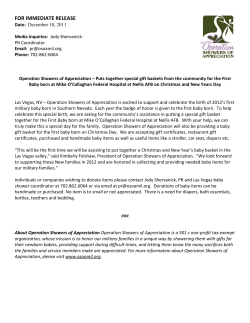
case communications
Case Communications IMAJ • VOL 14 • august 2012 Trisomy 18: How Far Should We Go? Asaf Toker MD MHA1,2 and Liat Salzer MD MHA2 1 Hospital Management, Schneider Children’s Medical Center of Israel, Petah Tikva, Israel Department of Health Systems Management, Faculty of Health Sciences, Ben-Gurion University of the Negev, Beer Sheva, Israel 2 Key words: trisomy 18, ethics committee, futile treatment IMAJ 2012; 14: 515-517 For Editorial see page 498 Tmon genetic trisomy after trisomy risomy 18 is the second most com- 21. The trisomy has a quoted incidence of 1/3000–1/8000 live births [1] and is characterized by severe psychomotor and growth retardation and associated cardiac, renal and central nervous system abnormalities. Approximately 95% of conceptuses with trisomy 18 die as embryos or fetuses, and the median life expectancy for an infant with non-mosaic trisomy 18 who does not receive intensive care treatment is cited as 2–70 days [2]. Longterm survival up to age 27 years has also been reported [3-5], but these cases are rare, and factors influencing survival are largely unknown [6]. In those who do survive beyond infancy, severe psychomotor and growth retardation are invariably present. Some have suggested that long-term survival of infants with trisomy 18 is associated with more aggressive management [7,8]. Although more than 90% of patients with trisomy 18 have congenital heart disease [9], cardiac malformations are not often directly lethal [1] and it has been claimed that surgical treatment does not improve their survival [1,2,9]. There are no criteria for surgical treatment of congenital heart malformations in patients with trisomy 18 [9]. Opinions supporting aggressive surgical treatment for congenital heart malformations for these patients may be based on recent advances in neonatal care [9]. Kosho et al. [10] reported that mechanical ventilation, surgical correction of gastrointestinal and respiratory complications, and active medical treatment of congenital heart malformations in 24 patients with trisomy 18 improved the 1 year survival rate to 25%. The 2 year survival rates for patients who had or had not undergone surgical treatment for congenital heart malformations were 45% and 5% respectively [9]. Still, it is unclear whether heart surgery improves the long-term survival for these patients. One of the most challenging ethical dilemmas in neonatal medicine is whether to offer aggressive resuscitative and surgical treatment for infants diagnosed as having a poor prognosis due to genetic anomalies. Historically, there has been a consensus that trisomy 18 is lethal and, therefore, even resuscitation was not indicated; but, as mentioned earlier, the word “lethal” requires further investigation. According to the most recent guidel i nes f rom t he A mer ica n Hea r t Association regarding cardiopulmonary resuscitation and emergency cardiovascular care of pediatric and neonatal patients [11], “It is possible to identify conditions associated with high mortality and poor outcome in which withholding resuscitative efforts may be considered reasonable, particularly when there has been the opportunity for parental agreement.” Based on these guidelines, when gestation, birth weight, or congenital anomalies are associated with almost certain early death and when unacceptably high morbidity is likely among the rare survivors, resuscitation is not indicated. Examples may include extreme prematurity, anencephaly, and chromosomal abnormalities incompatible with life, such as trisomy 13. As also mentioned in another study [12], it is interesting that these latest guidelines omitted trisomy 18 from the list of examples of conditions for which resuscitation is not indicated. One study [12] checked the current approach of neonatologists to estimate whether there was a change of attitude. The study found that indeed the approach had changed – from the “patient’s best interest” to a more passive approach that gives more weight to the parental preferences. It is also speculated that this might be a byproduct of the strong emphasis bioethics has placed on patient autonomy, and the extension of this concept to “parental autonomy” in decision making for children [12]. In this article we present the case of a female infant with trisomy 18 who was hospitalized in our medical center. We describe her medical condition, the decision-making process, and the involvement and impact of the hospital’s local ethics committee. Patient Description This baby girl was born to an ultraOrthodox Jewish family in March 2010 following a normal full term pregnancy at 40 weeks with a birth weight of 2264 g. During pregnancy an ultrasound revealed a cardiac malformation and additional structural defects, but the parents refused amniocentesis. After delivery the baby was transferred to the neonatal intensive care unit and 515 Case Communications was diagnosed with tetralogy of Fallot, pulmonic atresia, dysmorphism, dysplastic polycystic kidney, and thin corpus collosum. Genetic testing revealed trisomy 18. The baby was given prostaglandins without inotropic support, and mechanical ventilation was initiated due to central apnea. At the age of 2 weeks the case was brought to the local ethics committee to discuss treatment options for a baby with a complex cardiac malformation and the above genetic diagnosis. Ethics committees are mandated in the Israeli health care system by the 1996 Israel Patient’s Rights Act. According to this act, each medical organization must have an ethics committee with at least five members, including: • A chairperson, who must be a person who is qualified to be appointed as a district judge, selected from a list published by the Ministry of Justice • Two specialist physicians, each from a different subspecialty • A psychologist or a social worker • A public representative or a religious functionary. The local ethics committee invited all the physicians and staff who were treating the baby in the intensive care unit, neonatologists, cardiologists, and the baby’s parents, to discuss treatment options for such a complex medical condition with poor prognosis according to the best interest of the baby. After a long debate the ethics committee recommended that the medical teams perform heart surgery; this decision was based largely on the updated literature [9,10] that reported better prognosis for babies with trisomy 18 who underwent heart surgery. At the age of 1 month the baby girl underwent open heart surgery during which a right ventricle-pulmonary artery graft was performed to partially correct the tetralogy of Fallot. Mechanical ventilation was clinically difficult to withdraw and the baby was ventilated for 4 weeks after the surgery. A week after the withdrawal of ventila516 IMAJ • VOL 14 • august 2012 tion the baby needed reintubation and ventilation for another 10 days. During her hospitalization in the cardiac intensive care unit, there was a rise in liver enzymes and gastrointestinal workup revealed cholestatic jaundice. She was discharged from our hospital at the age of 3 months for further ambulatory gastrointestinal and cardiac follow-up, with home oxygen therapy. Two months after her discharge, following a routine gastrointestinal clinic visit, the baby was again admitted to our hospital for intense investigation of her cholestatic jaundice. The investigation revealed biliary atresia and the medical team approached the ethics committee for the second time to discuss treatment options. The second et h ics com m it tee included all the personnel who were involved in the baby’s medical treatment, including cardiologists, gastroenterologists, intensive care unit physicians, social workers, and the parents. It was now clear that even after the heart surgery the prognosis of the baby was grim and her chances for surviving the Kasai operation were low. Furthermore, liver transplantation was not an option in this case and all the treatments were considered futile. The major challenge was to agree on how far we should treat this baby and the limits of our treatment. Because the prognosis was so poor, most of the treatments were considered futile, and in order to prevent additional suffering for the baby it was agreed by the committee that only supportive care be offered. The limits of treatment in case of deterioration in the baby’s condition were clear to the staff after the decision was made. The baby was in the general pediatric department where she passed away a few days after the committee meeting. Comment This article presents the case of a known genetic disorder, trisomy 18, with poor prognosis and the ethical dilemmas in an advanced technological world. Medical personnel around the world are committed to several core principles of medical ethics. Principles such as autonomy (patients’ right to refuse or choose their treatment), beneficence (acting in the best interest of the patient), non-maleficence (“first, do no harm”), justice, dignity, truthfulness and honesty are considered in every case treated and should be analyzed in cases with ethical dilemmas such as the case presented here. One of the cardinal ethical dilemmas encountered in neonatology is whether to offer aggressive measures for infants diagnosed with known severe chromosomal abnormalities that have an extremely poor prognosis. In those cases, treatment is usually futile and causes additional pain and suffering to the patient and the family. Physicians offer medical and surgical treatments because they hope that this case will be exceptional and the child will survive. Trisomy 18, considered in the past as a lost case, is now an issue of controversy. While previously known that the prognosis is exceptionally grim, it is now known that in some cases survival may be longer. The futile use of surgical procedures and intensive care resources to treat such cases should be well known to the staff involved, since pain and suffering without offering any reasonable hope of benefit to the baby and its family is unjustified. Although it may appear to be against physicians’ primary feelings, beliefs and role to treat such patients, physicians sometimes have the obligation to not offer therapy, regardless of the wishes of the family, because the intervention would be futile. The ethical principle of non-maleficence (Do no harm) is determinative here. While the principle of beneficence – doing what is best for the individual identified patient – is still the dominant guiding principle of medicine, several other principles have to be discussed. The principle of autonomy of the Case Communications IMAJ • VOL 14 • august 2012 patient is complex when the patient is a minor with mental retardation. The best interest of the patient is also not clear cut. The values conflict even more when the principle of non-maleficence (Do no harm) is a consideration. It seems that sometimes the decisions have to be not only about justice, but also about prioritizing justice. The role of the ethics committee is crucial. In circumstances such as described above, it is the committee’s responsibility to resolve and clarify any conflicts between parents and physicians, as well as among physicians. It should take into account both the best interests of the infant and parental autonomy, and then set clear boundaries based on medical knowledge. The era in which we live today poses two critical dilemmas for the ethics committees. First, the rapid technological improvements in neonatal medicine may make past research irrelevant. Often data on current treatments are insufficient, which makes it harder for the committee to decide what “futile treatments” are. Second, there is more emphasis on “patient autonomy” in medicine, also due to the increased accessibility to knowledge. In the present case, “patient autonomy” was not possible, and “parental autonomy” took its place. The best-case scenario is to obtain parental consent for the committee’s decision, but this is not always possible. In cases that are not “clear cut,” the committee should be able to withstand pressure. Ethical dilemmas will become increasingly more common in health care systems. The key question will invariably be … how far should we go? Corresponding author: Dr. A. Toker Hospital Management, Schneider Children’s Medical Center of Israel, Petah Tikva 49202, Israel Phone: (972-3) 925-3770 Fax: 972-3-924-7515 email: asatoker@gmail.com References 1. Embleton ND, Wyllie JP, Wright MJ, Burn J, Hunter S. Natural history of trisomy 18. Arch Dis Child Fetal Neonatal Ed 1996; 75 (1): F38-41. 2. Rasmussen SA, Wong LY, Yang Q, May KM, Friedman JM. Population-based analyses of mortality in trisomy 13 and trisomy 18. Pediatrics 2003; 111 (4 Pt 1): 777-84. 3. Kelly M, Robinson BW, Moore JW. Trisomy 18 in a 20-year-old woman. Am J Med Genet 2002; 112 (4): 397-9. 4. Lebel RR, Roberson J, Van Dyke DL. Regarding trisomy 18. Am J Med Genet A 2006; 140 (9): 964-5. 5. Shanske AL. Trisomy 18 in a second 20-year-old woman. Am J Med Genet A 2006; 140 (9): 966-7. 6. Piastra M, Caresta E, Chiaretti A, Polidori G, Pardeo M, De Rosa G. Intensive care in an adolescent with trisomy 18: an ethical dilemma. Eur J Pediatr 2003; 162 (11): 814-15. 7. Goldstein H, Nielsen KG. Rates and survival of individuals with trisomy 13 and 18. Data from a 10-year period in Denmark. Clin Genet 1988; 34: 366-72. 8. Hecht F. Who will survive with trisomy 13 or 18? A call for cases 10 years old or above. Am J Med Genet 1981; 10: 417-18. 9. Yamagishi H. Cardiovascular surgery for congenital heart disease associated with trisomy 18. Gen Thorac Cardivasc Surg 2010; 58: 217-19. 10. Kosho T, Nakamura T, Kawame H, Baba A, Tamura M, Fukushima Y. Neonatal management of trisomy 18: clinical details of 24 patients receiving intensive treatment. Am J Med Genet A 2006; 140: 937-44. 11. American Heart Association, American Academy of Pediatrics. 2010 American Heart Association guidelines for cardiopulmonary resuscitation and emergency cardiovascular care of pediatric and neonatal patients: neonatal resuscitation guidelines. Pediatrics 2010; 126: 1400-13. 12. McGraw MP, Perlman JM. Attitudes of neonatologists toward delivery room management of confirmed trisomy 18: potential factors influencing a changing dynamic. Pediatrics 2008; 121 (6): 1106-10. Capsule Neural tissue supports the continued formation of neuronal structures while maintaining a pool of progenitors During development of the cortex of the mammalian brain, radial glia divide asymmetrically to give rise to apical progenitor cells that continue to divide and cells that differentiate into neurons. Thus, the tissue supports the continued formation of neuronal structures while maintaining a pool of progenitors. Tsunekawa et al. report on a mechanism that influences the fate of the daughter cells. Radial glial cells have long thin apical and basal processes that extend from either end of the cell. mRNA encoding the cell cycle regulator cyclin D2 was preferentially localized and translated in the basal process because of a regulatory sequence in the 3’ untranslated region of the mRNA. The daughter cell that inherited the basal process thus got most of the cyclin D2 and continued to proliferate. The other daughter cell, perhaps because of a prolonged cell cycle, or effects of other sequestered factors, underwent neuronal differentiation. A causal role of cyclin D2 was supported by experiments depleting or overexpressing the protein, which caused the accumulation of proliferating progenitor cells or increased neurogenesis, respectively. EMBO J 2012; 31: 1879 Eitan Israeli The happiness of the bee and the dolphin is to exist. For man it is to know that and to wonder at it Jacques Cousteau (1910-1997), French naval officer, explorer, filmmaker, innovator, scientist, photographer, author and researcher who studied the sea and all forms of life in water. He co-developed the Aqua-Lung and pioneered marine conservation 517
© Copyright 2025

















